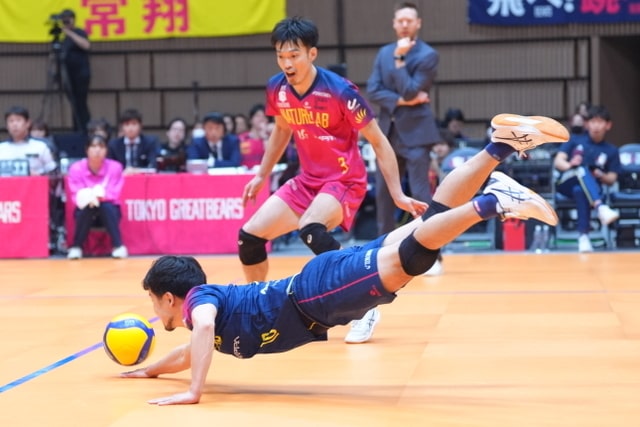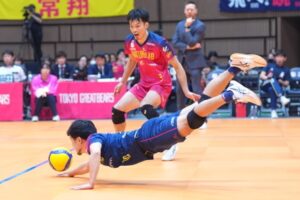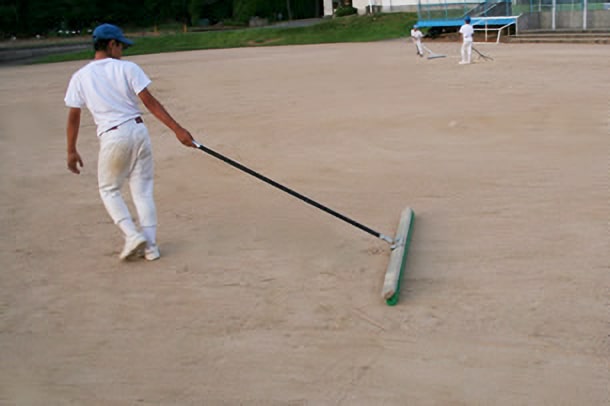
Digging in volleyball is an important defensive technique that is often seen throughout the game.
This technique is essential, especially for preventing opponent attacks and turning the flow of the match in your team’s favor.
A successful dig provides an opportunity to create a transition point on offense rather than just keep the ball in play.

目次
What is volleyball digging?

What is the difference between dig and receive?
What does Dig stand for?
Dig is an abbreviation for digging up the ball.
Basic techniques of volleyball
Volleyball has some basic techniques and these are very important to play the game.
Below are the main basic techniques in volleyball
1. Service
- Floater serve : A serve that creates an irregular trajectory by hitting the ball without applying any rotation.
- Jump serve : A serve that increases speed and power by delivering a powerful spike-like serve while jumping.
- Underhand serve : A serve suitable for beginners that supports the ball from below and launches it upwards.
2. Pass
- Forearm pass (bump) : A technique for controlling and raising the ball by extending both arms. Used for serve receive and dig.
- Setting : The technique of controlling the ball using the fingertips and raising it high and accurately for attack.
3. Attack
- Spike : An attack technique that forces the ball down. Jump high and forcefully drive the ball into the opponent’s court.
- Dunk : An attack in which you lightly poke the ball to catch your opponent by surprise.
- Off-speed hit : A technique in which the ball is slowly dropped into an open area of the opponent’s court.
4. Block
- Single Block : A technique in which one person blocks an opponent’s spike.
- Double Block : A technique where two people work together to block.
- Triple block : The most powerful block made by three people working together.
5. Defense
- Dig : A technique to catch the ball from a low position and prevent it from falling to the ground. Especially used against powerful spikes and attacks.
- Cover : A technique used to make the ball playable again when an attack is blocked.
These skills form the basis of volleyball play and are essential for effective play and teamwork.
By learning these skills and applying them appropriately depending on the situation, players can lead to success in the game.
Basic knowledge of volleyball
Volleyball is a competitive sport played between two teams across a net, with each team usually consisting of six players.
The object of the game is to score points by dropping the ball into the opposing team’s court, and the first team to reach a set point wins the set.
Typically, 3 or 5 set matches are played, with the team winning the most sets winning. Below are details about the basic knowledge of volleyball
1. Coat and equipment
- Court size : The volleyball court is rectangular and divided into dimensions of 18m x 9m. The court is divided into two equal sized areas by a central net.
- Net height : 2.43m for men and 2.24m for women.
- Ball : A circular shape with air inside, the circumference is 65-67cm, and the weight is 260-280g.
2. Basic rules
- Serve : Hit the ball from behind into the opponent’s court to start the game.
- Rally : Both teams hit the ball back until the ball falls into the court, is out, or is fouled.
- Rotation : Rotate positions clockwise each time a team wins the right to serve.
- Point System : Previously, there was no rally point system, where only the serving team could earn points, but now there is a rally point system, where either team can earn points.
3. Main technologies
- Serve : A technique that initiates an attack. These include floater serves and jump serves.
- Reception : The technique of receiving an opponent’s serve or attack.
- Set : The technique of raising the ball after a receive or dig to prepare for attack.
- Attack (spike) : A technique to attack the opponent’s court by hitting the ball strongly.
- Blocking : A technique to prevent an opponent’s attack online.
- Dig : This action is mainly used to protect the ball that falls near the ground.
4. Match progress
- Sets : Usually each set is worth 25 points (the final set is worth 15 points) and is played until there is a two-point lead.
- Timeouts and Substitutions : Strategic breaks and substitutions can be made during the game.
Volleyball is a sport that relies on teamwork, strategy, and individual skill, and players must be familiar with these fundamentals.




